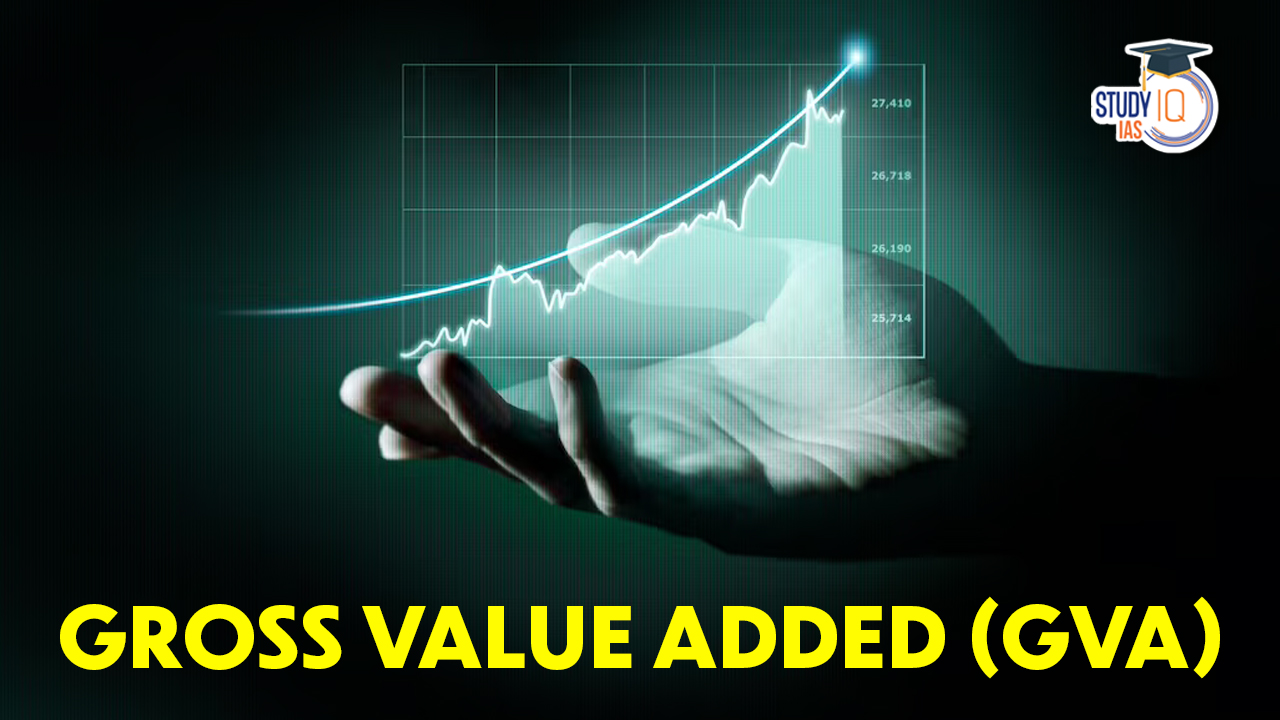Table of Contents
Gorss Value Added (GVA)
Gross Value Added (GVA) is a crucial macroeconomic indicator that assesses the value of goods and services produced in an economy, accounting for the costs of inputs and raw materials utilized in the production process. It is a fundamental concept for UPSC exam aspirants to grasp, as it provides insights into a country’s economic performance and allows for the evaluation of sector and industry contributions to overall economic growth.
Read about: Gross National Product
Concept of GVA
The concept of Gross Value Added (GVA) is a measure used to assess the economic value generated by various sectors or industries within an economy. It provides a clearer understanding of the contribution made by each sector to the overall economic output.
GVA takes into account the value of goods and services produced by subtracting the cost of intermediate inputs from the total value of production. By focusing on the value added at each stage of the production process, GVA helps analyze the productivity and efficiency of different sectors, enabling policymakers and economists to evaluate economic performance, identify growth drivers, and make informed policy decisions.
Read About: Circular Flow of Income
Formula of GVA
The formula for Gross Value Added (GVA) is as follows:
GVA = GDP – Taxes + Subsidies
By subtracting taxes and adding subsidies, GVA provides a more accurate measure of the actual value generated by industries and sectors of the economy, excluding the impact of taxes and subsidies.
Read about: External Debt of India
Difference Between GVA and GDP
The following table comprehensively analyses the difference between Gross Value Added and Gross Domestic Product.
| Gross Value Added (GVA) | Gross Domestic Product (GDP) | |
| Definition | Measures the value of goods and services produced, deducting the cost of inputs and raw materials used in production. | Measures the total value of goods and services produced within a country’s borders, regardless of ownership. |
| Focus | Focuses on the production side of the economy. | Focuses on the income side and expenditure side of the economy. |
| Components | Includes only the value added by each sector or industry. | Includes value added by each sector or industry, plus taxes and subsidies on products and net income from abroad. |
| Exclusions | Excludes indirect taxes and subsidies. | Includes indirect taxes and subsidies. |
| Calculation | Calculated by summing the value added by each sector. | Calculated by adding consumption, investment, government spending, and net exports. |
| Purpose | Provides insights into sectoral contributions and productivity. | Provides a comprehensive measure of economic activity and growth. |
| Policy Implications | Helps identify growth drivers and sectoral performance. | Guides policymakers in formulating economic policies and assessing overall economic health. |
Read about: Concept of GDP, GNP, NNP and NDP
Benefits of Gross Value Added (GVA)
The benefits of using Gross Value Added (GVA) as a measure of economic growth are:
- Sector-specific Insights: GVA provides a breakdown of value added by each sector or industry, allowing policymakers to identify the sectors driving economic growth and those that require attention.
- Productivity Assessment: GVA helps assess the efficiency and productivity of different sectors by comparing the value of outputs to the inputs used in production.
- Business Cycle Analysis: GVA can be used to analyze the business cycle and identify periods of expansion or contraction in specific sectors, providing valuable information for policymaking and planning.
- Regional Comparisons: GVA enables comparisons of economic performance across regions, helping policymakers understand regional disparities and devise targeted development strategies.
- Policy Formulation: GVA serves as a useful tool for formulating sector-specific policies and interventions aimed at promoting growth, investment, and employment generation.
Read about: GDP Deflator
Issues Related to Gross Value Added
Issues related to Gross Value Added (GVA) include:
- Overestimation of Value: GVA may overestimate the value created in an economy since it does not consider the depreciation of capital assets, potentially leading to an inflated measure of economic activity.
- Impact of Subsidies and Taxes: Changes in subsidies and taxes can affect the calculation of GVA, resulting in fluctuations in the indicator and making it less stable as a measure of economic growth.
- Inaccurate Representation of the Informal Sector: GVA may not accurately capture the contribution of the informal sector to the economy, as it primarily focuses on formal sector activities. This can result in an incomplete picture of the overall economic performance.
Read about: NRI Deposits
Gross Value Added UPSC
Understanding Gross Value Added (GVA) is crucial for UPSC aspirants, as it is a key concept covered in the UPSC Syllabus under the Economics section. GVA serves as an important macroeconomic indicator used to measure the value of goods and services produced in an economy. Knowledge of GVA is vital for comprehending the overall economic performance of a country and analyzing the contribution of different sectors to economic growth. Aspirants can gain familiarity with such concepts by reaching out to UPSC Online Coaching platforms, and check their conceptual clarity by attempting UPSC Mock Test.
Read about: FERA and FEMA


 Goods and Services Tax (GST), Objectives...
Goods and Services Tax (GST), Objectives...
 World Oceans Day 2025, History, Theme, S...
World Oceans Day 2025, History, Theme, S...
 World Environment Day 2025, Theme, Histo...
World Environment Day 2025, Theme, Histo...





















